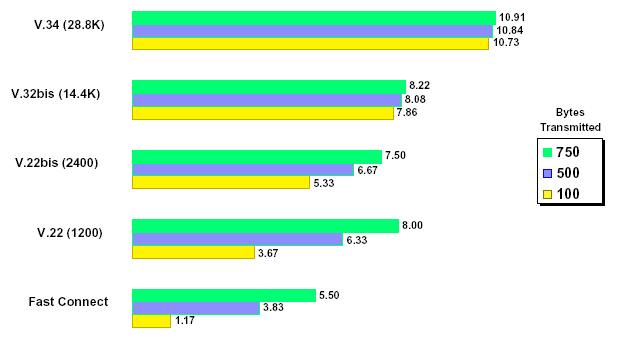
|
Quick Connection modems |
The Quick Connection
Modem:
The Key to Lower Cost telephone bills
Time is money - ask any business man. Transaction based applications can be better suited to a modem that can connect quickly on small transactions blocks of data. A quote "High Speed Modem" may take more time to connect that it uses to transmit the data. The following are some concepts to contemplate when designing a dial network.
Raw Speed vs. Faster Handshakes
.What's easy to overlook, that with each new advancement in modem speed has come a correspondingly more complex connection process. Higher speed modems require more connect time to deal with such extra factors as timing, adaptive equalization, echo canceling and line probing. Table A summarizes this phenomenon for 1200 to 28.8 Kbps modems. Higher speed modems are great for a wide variety of applications. What happens, though, when you need to transmit far smaller amounts of data, like say 100 bytes? When using high-speed modems it can create an inefficient situation where just getting connected gobbles up a big chunk of your total transmission time. A workhorse 1200 bps modem can connect and transmit 100 bytes of data in less than 4 seconds-over 4 seconds faster than the total time a 14.4 Kbps modem takes. Check it out on Figure 1. Multiply that 4 seconds by thousands of transactions and suddenly we're talking a lot of time. Time that costs money - ether in the total number of transaction per period of time or in higher long distance cost. You may think "if there is no long distance charges who cares". Consider this - cost will be higher because of the added modems and dial lines that will be required at the central communication site.
Connect Time vs. Transmission Rate

1,200 & 2,400 bps Modems: The Low-Cost
Solution for Transaction Processing
So a curious thing has happened. In the drive to make ever faster modems for large-file applications, designers of high speed modems have introduced products with less and less benefit for most short, high volume transaction processing applications. This is particularly true for many embedded applications-everything from ATM machines and credit card authorization systems to set-top boxes, point-of-sale terminals and remote sensor data logging systems. Here, you are best served by the seemingly slower - and definitely less expensive - 1200 bps or 2400 modem. This minimal handshake time will help complete a higher volume of short transmissions of up to 750 bytes much more quickly and cost-effectively than 14.4 Kbps modem. You can see this on Figure 2, which compares the total line time used by different modems for 4 data transactions. For example, the TSC 73K222AL single-chip modem with V.22 makes its average connection in 3.0 seconds, compared with 7.8 seconds for a 14.4 Kbps modem.
Typical Small Data Transactions

Table A: AVERAGE CONNECT TIME
| Table A: AVERAGE CONNECT TIME | ||
|
Modem Connect Technique |
Max Data Rate |
Average Connect Time |
|
Instant Connect 222 * |
1,200 bps |
0.1 second |
|
Fast 222 ** |
1,200 bps |
0.5 second |
|
Quick 222 ** |
1,200 bps |
1.5 seconds |
|
Bell 212 |
1,200 bps |
2.5 seconds |
|
V.22 |
1,200 bps |
3.0 seconds |
|
V.22 bis |
2,400 bps |
5.0 seconds |
|
V.32 bis |
14.4 kbps |
7.8 seconds |
|
V.34 |
28.8 kbps |
10.7 seconds |
* When using low speed modems (such as a V.22 modem) the connect time can be significantly shortened, especially when the system designer has specified both the local and remote ends of the system. If echo suppressors are not present the 73K222 can connect in as little as 0.1 seconds. This represents the shortest possible synchronization time for a connect.
** At the beginning of a call within the PSTN , a tone with a minimum duration of 400 ms (usually the modem answer tone) is used to disable the network echo suppressors, necessary for full duplex transmission. Using a device such as the TSC 73K222 single chip modem, a V.22 style handshake can be executed in as little as 0.5 to 1.5 seconds, depending on system design requirements.
jump to Quick Connect Modems
ARC ELECTRONICS
301-924-7400 EXT 25
jump to ... Home Page
arc@arcelect.com